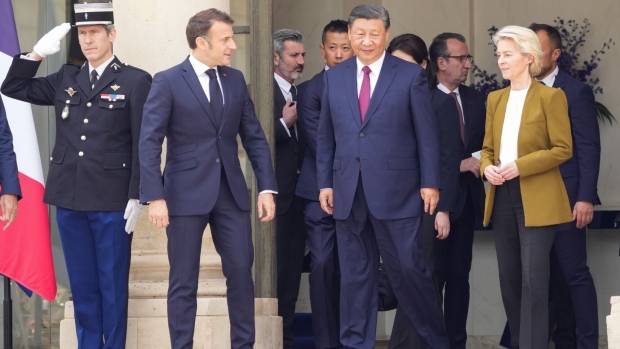May 9, 2024
How Xi’s Europe Trip Is Reviving Europe’s Cold War Divide
, Bloomberg News

(Bloomberg) -- Other than photo opportunities and some local delicacies, Chinese President Xi Jinping didn’t get — or give — much during his two days in France with President Emmanuel Macron this week. Yet Xi’s swing through Eastern Europe proved more productive, allowing him to add Serbia to the list of countries supporting his vision of global order and lean into the increasingly strained relationship between Hungary and the European Union. Although Xi talked about avoiding a “new Cold War,” his diplomacy has revived the divisions of the last one by pitting Europe’s east against west. Here are some of the key takeaways from the trip — and what to watch in the months ahead.
No Dealmaking in France
Macron had hoped that, through building a closer personal connection, he could persuade the Chinese leader to influence Vladimir Putin to end Russia’s war in Ukraine. But Xi hasn’t shifted China’s stance much. “China understands the repercussions of the Ukraine crisis on the people of Europe,” he wrote in an op-ed published in the French newspaper Le Figaro. That’s about as much empathy Xi has shown since the beginning of the conflict.
European Commission President Ursula von der Leyen, who joined a trilateral meeting in Paris, also highlighted the war’s “existential nature.” Xi later pushed back on Brussels’ pressure and warned against using the conflict as a tool to criticize China.
If Xi had hoped to drive a wedge between the EU and the US, he didn’t get much success. After a meeting with Xi, von de Leyen said that the bloc is prepared to use all tools available to push back what she called China’s unfair trade practices, which remain a concern in the US. Xi has categorically denied such claims.
Playing Nice Earns More Yuan
Xi announced a range of new investments in Budapest while touting Prime Minister Viktor Orban’s Hungary as a model for what the European Union’s relationship could look like with the world’s second-largest economy. He also brought pledges to build infrastructure that will help spread products across the trading bloc from Chinese factories planned for Hungary. BYD Co., the Chinese EV giant, previously picked the country as the site of its first European car factory; the country is also a hub for battery production.
Hungary’s cash-strapped government has been looking to lock in financing and fresh stimulus for its economy. Among the agreements is money for a costly upgrade of the country’s aging rail network and the construction of a long-delayed connection between Budapest Airport and the capital’s downtown, according to Foreign Minister Peter Szijjarto. Hungary will also seek to deepen cooperation with Huawei to advance digitalization in the country.
No Limits with Serbia
Serbian President Aleksandar Vucic threw Xi a grand reception in Belgrade, with a crowd cheering and waving national flags. The scene was a PR win for him in China, as was Xi’s wining and dining in France — which even became a trending topic on the social media platform Weibo.
Vucic declared “the sky is the limit” between the two countries, an echo of Moscow’s no-limits friendship with Beijing (and perhaps a reminder of support for Russia and its agenda). Xi also got Serbia to sign up to be a “community with a shared future,” becoming the first European country to join China’s efforts to build a coalition that challenges the US-led world order.
As a show of economic benefits a friendly partner could enjoy from China, Xi said a Free Trade Agreement with Serbia will take effect on July 1, adding that his nation will expand imports of agricultural products and begin more direct flights. The two country’s central banks will also work on a clearing arrangement in yuan to help strengthen their business and trade ties. Serbia also says it would keep a portion of its foreign currency reserves in yuan, proportionate to the nation’s debt to China, which is rising.
Pivoting to the East, Again
In Hungary, Xi praised Orban’s “independent” foreign policies, as he called for Budapest to lead the region’s relations with China. Chinese state media went so far as to call Hungary “the most Western of Eastern nations,” in an attempt to highlight cultural similarities between the two countries. (There aren’t many.)
This isn’t China’s first effort to divide the bloc. Beijing set up a mechanism to strengthen ties with 16 central and eastern European nations in 2012. But enthusiasm for the framework gradually waned; countries bristled at widening trade balances while China also failed to deliver on pledges of billions of dollars in investments. (Then came Russia’s invasion of Ukraine, which triggered a broader re-think of relations with China.) Lithuania and three Baltic nations have all formally announced their decision to quit, effectively rendering the format obsolete.
In Belgrade, Xi also vowed to “never forget” the bombing of the Chinese embassy by NATO forces on the 25th anniversary of the attack. US missiles killed three Chinese journalists in a 1999 strike that the White House later called a mistake and blamed on faulty maps. Xi didn’t seem to have visited the site of the former embassy.
What to Watch Next
China and France signed 18 bilateral cooperation agreements during Xi’s visit. There is likely a truce on cognac; China’s Ministry of Commerce started an anti-dumping investigation into liquor products from the EU earlier this year, a move that came in response to the EU opening a probe into China’s electric vehicle subsidies last October. The EU can impose provisional EV subsidies after nine months, so that July deadline is approaching. Xi also said that China “welcomes” French farm products and cosmetics, but if the disputes over China’s excessive manufacturing capacity evolve into a trade war, these areas could easily become the next targets.
And as for Ukraine, Putin’s upcoming visit to Beijing will show just how much Macron might’ve been able to sway Xi.
©2024 Bloomberg L.P.






